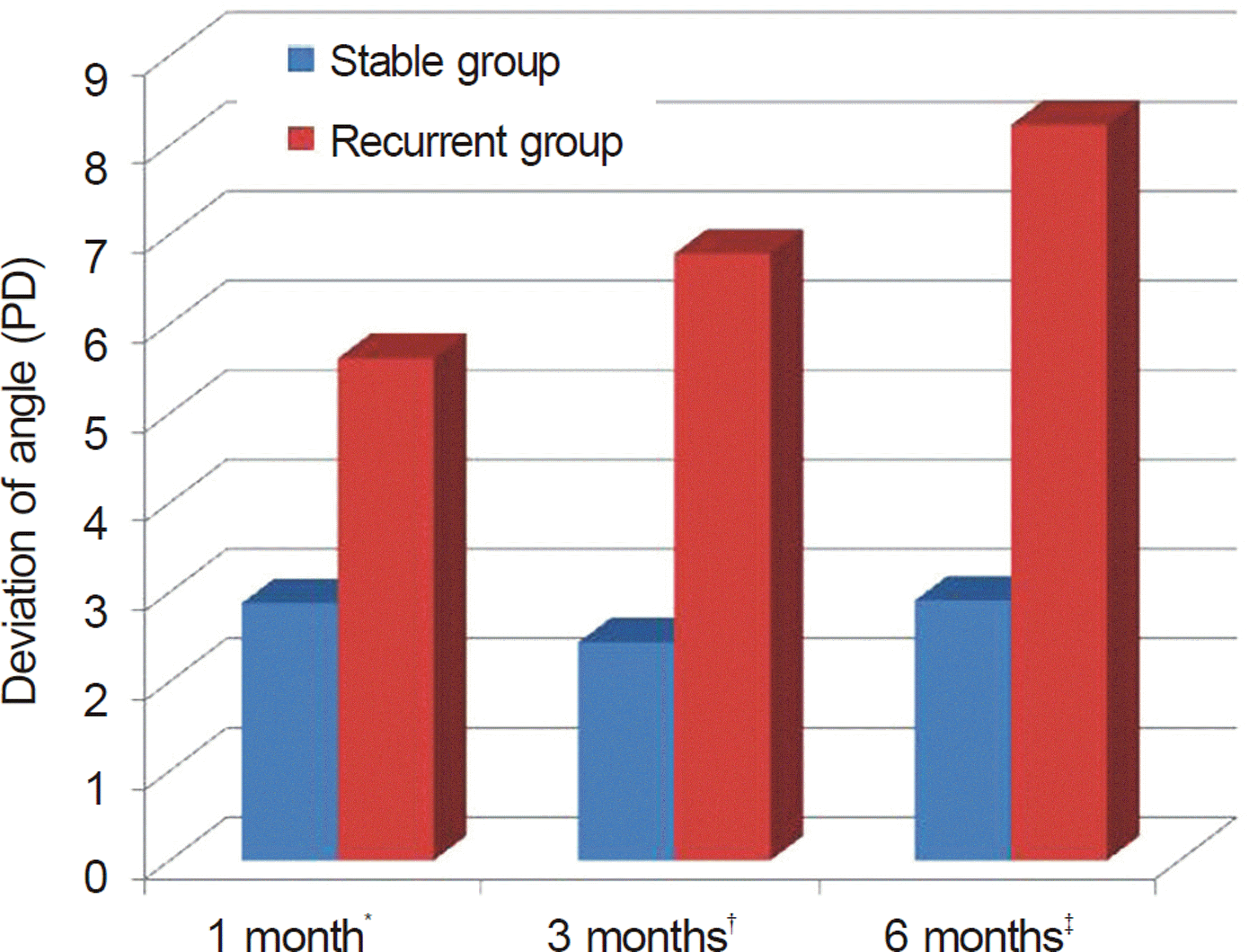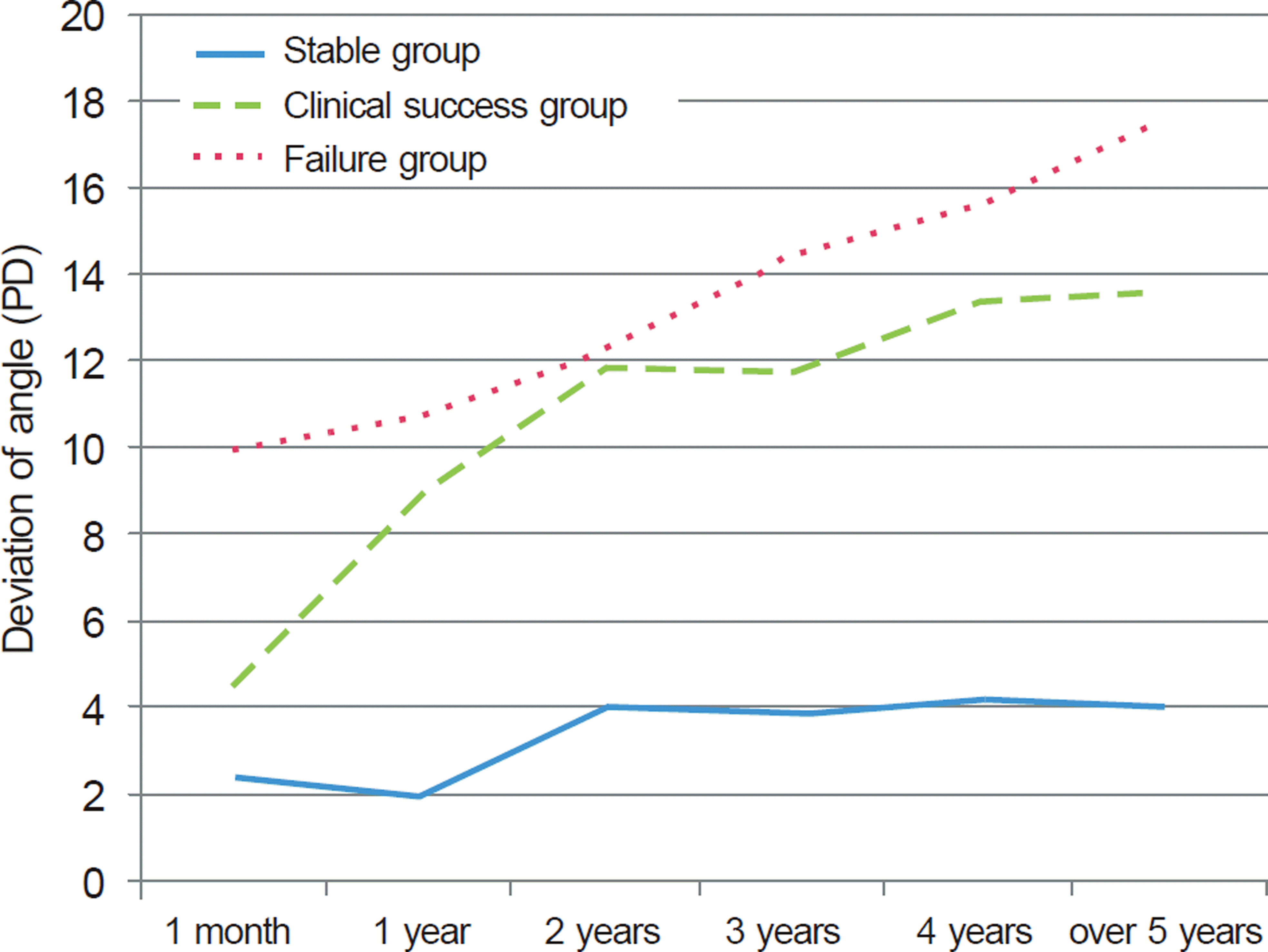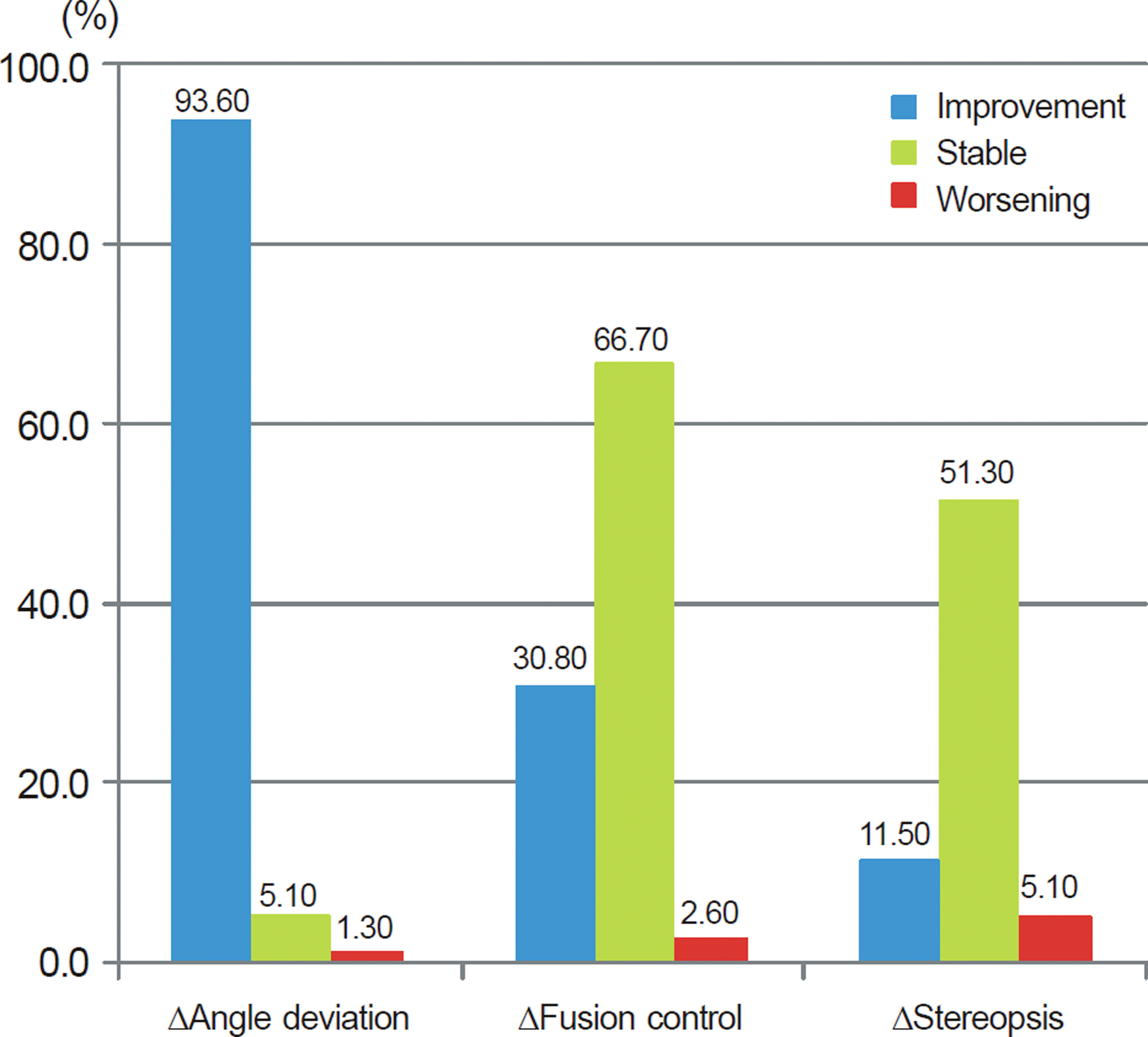Abstract
Methods
The authors evaluated 78 patients who underwent surgery for intermittent exotropia and were available for a fol-low-up over a 5-year period. According to distant exodeviation and fusion control at the last visit, the patients were classi-fied into either the stable group (distant exodeviation ≤10 PD) or the recurrent group (distant exodeviation >10 PD). The re-current group was reclassified into the clinical success group (distant exodeviation >10 PD, <20 PD with good fusion con-trol) or the clinical failure group (distant exodeviation ≥20 PD or distant exodeviation >10 PD, <20 PD with poor fusion con-trol). We analyzed recurrence rate, success rate, and clinical outcome.
Results
Recurrence rate was 65.3% (n = 51), and the surgical success rate calculated as the rate of stable group and clin-ical success group was 73% (n = 57). The postoperative angle of exodeviation was more decreased than the preoperative angle in 93.6% of patients. When comparing postoperative with preoperative sensory function, only 2.6% of patients dem-onstrated worse distant fusion control grades, 66.7% of patients remained the same, 30.8% improved, and 5.1% of pa-tients demonstrated poorer near stereopsis. The rest of patients had better or equal fusion control and stereoacuity. Age at surgery in the recurrent group was less than in the stable group ( p = 0.004) and the recurrent group had worse pre-operative distant fusion control ( p = 0.021). Exodeviation angle of the recurrent group at postoperative 1 month, 3 months and 6 months was greater than that of the stable group ( p < 0.005).
References
1. Jenkins R. Demographics geographic variations in the prevalence and management of exotropia. Am Orthop J. 1992; 42:82–7.

2. Ing MR, Pang SWL. The racial distribution of strabismus. Reike RD, editor. Strabismus III ed. New York:: Grune & Stratton;1978. p. 107–9.
3. Yu YS, Kim SM, Kwon JY, et al. Preschool vision screening in Korea: Preliminary study. J Korean Ophthalmol Soc. 1991; 32:1092–6.
4. Scott WE, Keech R, Mash AJ. The postoperative results and stabil-ity of exodeviations. Arch Ophthalmol. 1981; 99:1814–8.

5. Ing MR, Nishimura J, Okino L. Outcome study of bilateral lateral rectus recession for intermittent exotropia in children. Ophthalmic Surg Lasers. 1999; 30:110–7.

6. Kim MM, Cho ST. Long-term surgical results of intermittent exotropia. J Korean Ophthalmol Soc. 1994; 35:1321–6.
7. von Noorden GK, Campos EC. Exodeviations. Binocular vision and ocular motility, 6th ed. St. Louis:: Mosby;2002. p. 356–76.
9. Kim YW, Lee JY. Long-standing intermittent exotropia diagnosed in patients older than 16 years of age. J Korean Ophthalmol Soc. 2011; 52:1077–82.

10. Romano PE, Wilson MF, Robinson JA. World-wide survey of cur-rent management of intermittent exotropia by MD strabologist. Binoc Vision. 1993; 8:167.
11. Hahm KH, Shin MC, Sohn MA. The change in deviation angle with time course after surgical correction of intermittent exotropia. J Korean Ophthalmol Soc. 2002; 43:2214–9.
12. Maruo T, Kubota N, Sakaue T, Usui C. Intermittent exotropia sur-gery in children: long term outcome regarding changes in binocular alignment. A study of 666 cases. Binocul Vis Strabismus Q. 2002; 16:265–70.
13. Duane A. A new classification of the motor anomalies of the eyes based upon physiological principles, together with their symp-toms, diagnosis and treatment. Ann Ophthalmol Otolaryngol. 1986; 6:969.
15. Ruttum MS. Initial versus subsequent postoperative motor align-ment in intermittent exotropia. J AAPOS. 1997; 1:88–91.

16. Kushner BJ. Exotropic deviation: A functional classification and approach to treatment. Am Oorthopt J. 1988; 38:81–93.
17. Gezer A, Sezen F, Nasri N, Gözüm N. Factors influencing the out-come of strabismus surgery in patient with exotropia. JAAPOS. 2004; 8:56–60.
18. Keenan JM, Willshaw HE. The outcome of strabismus surgery in childhood exotropia. Eye (Lond). 1994; 8(Pt 6):632–7.
19. Raab EL, Parks MM. Recession of the lateral recti. Early and late postoperative alignments. Arch Ophthalmol. 1969; 82:203–8.

20. Lee JY, Choi DG. The clinical analysis of recurrence after surgical correction of intermittent exotropia. J Korean Ophthalmol Soc. 2002; 43:2220–6.
21. Ko KH, Min BM. Factors related to surgical results of intermittent exotropia. J Korean Ophthalmol Soc. 1996; 37:179–84.
22. Cooper EL. Purposeful overcorrection in exotropia. Arruga A, editor. International Strabismus Symposium, University of Giessen, Germany, Basel, S Karger. 1968; 311–8.

23. Hur J, Won IG. Surgical results of 79 cases of intermittent exo-tropia in children. J Korean Ophthalmol Soc. 1990; 31:1594–9.
24. Richard JM, Parks MM. Intermittent exotropia. Surgical results in different age groups. Ophthalmology. 1983; 90:1172–7.

25. Lim SH, Hwang BS, Kim MM. Prognostic factors for recurrence after bilateral rectus recession procedure in patients with inter-mittent exotropia. Eye (Lond). 2012; 26:846–52.

26. Pratt-Johnson JA, Barlow JM, Tillson G. Early surgery in inter-mittent exotropia. Am J Ophthalmol. 1977; 84:689–94.

27. Rah SH, Jun HS, Kim SH. An epidemiologic survey of strabismus among school-children in Korea. J Korean Ophthalmol Soc. 1997; 38:2195–9.
28. Nusz KJ, Mohney BG, Diehl NN. The course of intermittent exo-tropia in a population-based cohort. Ophthalmology. 2006; 113:1154–8.

29. Beneish R, Flanders M. The role of stereopsis and early post-operative alignment in long-term surgical results of intermittent exotropia. Can J Ophthalmol. 1994; 29:119–24.
30. Yeo SI, Kim SY, Hwang WS, Kong SM. Surgical results according to sensory function tests in intermittent exotropia. J Korean Ophthalmol Soc. 1999; 40:3174–9.
Figure 1.
Differences of exodeviation at postoperative 1, 3, 6 months. PD = prism diopter. * p = 0.008; † p = 0.000; ‡ p = 0.000; Analyzed with Independent t-test.

Figure 2.
Changes in postoperative deviation angle at distance in 3 postoperative groups. PD = prism diopter.

Figure 3.
Changes in angle deviation, fusion control, stereopsis between preoperative value and postoperative value at final visit.

Table 1.
Demographic data of total patients (n = 78)
Table 2.
Classifications for postoperative long term outcome
Table 3.
Comparisons of preoperative clinical factors among 3 postoperative groups
| Stable group | Clinical success group | Failure group | p-value | |
|---|---|---|---|---|
| Age in years at surgery (range) | 10.66 ± 6.22 (3-19 years) | 7.66 ± 1.72 (4-11 years) | 5.55 ± 2.90 (2-14 years) | 0.000* |
| Distant fusion control (good : bad) | 17 : 10 | 15 : 15 | 5 : 13‡ | 0.021† |
| Titmus stereopsis (seconds of arc) | 146.0 ± 163.39 | 140.5 ± 175.51 | 105.0 ± 343.56 | 0.508* |




 PDF
PDF ePub
ePub Citation
Citation Print
Print


 XML Download
XML Download